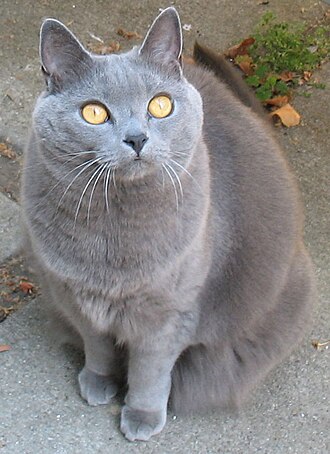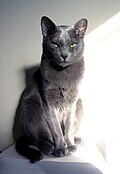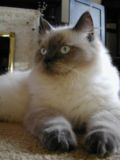Difference between revisions of "AY Honors/Cats - Advanced/Answer Key"
| Line 28: | Line 28: | ||
Image:Veda,chat-adulte-mâle-race-korat.JPG|'''1-c''' Korat, whose name in Thai means "Good Fortune" | Image:Veda,chat-adulte-mâle-race-korat.JPG|'''1-c''' Korat, whose name in Thai means "Good Fortune" | ||
Image:Ragdoll Blue Colourpoint.jpg|'''2-a''' Ragdoll cat, so name because it goes limp when picked up | Image:Ragdoll Blue Colourpoint.jpg|'''2-a''' Ragdoll cat, so name because it goes limp when picked up | ||
| − | Image:Sokoke_dalili.jpg|'''3-b''' | + | Image:Sokoke_dalili.jpg|'''3-b''' Sokoke cats originated in Kenya |
</gallery> | </gallery> | ||
====Korat==== | ====Korat==== | ||
Revision as of 02:17, 1 June 2007
1 Have the basic Cat Honor.
2. Know about cats "open-book" quiz. (This is not an instructional pass-a-test requirement, it is designed to encourage research into the world of cats.) Enjoy new discoveries as you research the following questions about some unusual domestic cat breeds from around the world.
a. The domestic cat known as Sphynx first appeared in the late 1960s. Which of the following is true about this Canadian breed?
(1) It is too wild to be a proper house cat.
(2) It is the national pet of Canada.
(3) It appears to be hairless.
The Sphynx (aka Canadian Hairless) is a rare breed of cat with extremely little fur, or at most a short fuzz over its body, and no, or very short and stiff whiskers. Their skin is the color their fur would be, and all the usual cat marking patterns (solid, point, van, tabby, tortie, etc) may be found in Sphynx too. They are sometimes mistaken for Chihuahuas because of their extremely unusual and, some say, uncatlike appearance. They are extremely intelligent, extroverted, and affectionate, often cuddling with their owners, other humans, and each other.
b. True or False: The Chartreux, with its brilliant orange eyes and blue lips, is a breed closely associated with France.
True.
The Chartreux is an internationally recognized breed of domestic cat from France. There is a legend that the Chartreux are descended from cats brought to France by Carthusian monks to live in the order's head monastery, the Grande Chartreuse, located in the Chartreuse Mountains north of the city of Grenoble (Siegal 1997:27). But in 1972, the Prior of the Grande Chartreuse denied that the monastery's archives held any records of the monks' use of any breed of cat resembling the Chartreux (Simonnet 1990:36–37). Legend also has it that the Chartreux's ancestors were feral mountain cats from what is now Syria, brought back to France by returning Crusaders in the 13th century, many of whom entered the Carthusian monastic order. The first documented mention of the breed was by the French naturalist Buffon in the 17th century. The breed was largely decimated during the first World War and wild populations were not seen after World War Two. A concerted effort by European breeders kept the breed from extinction. The first Chartreux were brought to the USA in 1971 by Helen and John Gammon of La Jolla, California. There are fewer than two dozen active Chartreux breeders in North America as of 2007.
c. Match the following cats with the special characteristics of their breed:
| (1) Korat (Thailand) | (a) Goes limp when picked up. |
| (2) Ragdoll (USA) | (b) Is traced to wild cats from Kenya. |
| (3) Sokoke (Denmark) | (c) Symbolizes good fortune. |
Korat
The Korat is one of the oldest stable breeds of cat. Originating in Thailand, it is named after the Nakhon Ratchasima province, although in Thailand it is often known as Si-Sawat, which means good fortune. In fact they are often known colloquially as the "Good Luck Cat" and are given in pairs to newlyweds or people of high esteem as a wish for good luck.
The first known written mention of the Korat was in "The Cat-Book Poems" authored between 1350 and 1767 AD in Thailand, now preserved in the National library in Bangkok. They first appeared in America in the 1950s and arrived in Britain from there in 1972.
Korats are a shorthair with a small to medium build and a low percentage of body fat; their bodies are often described as semi-cobby, and are surprisingly heavy for their size. They are an active cat and form strong bonds with people.
Korats have several characteristics that together distinguish them as a breed:
- Korats are one of a few breeds that have only one colour.
- Jean Johnson first introduced Korats to the US in 1959. She had lived in Thailand, where she first encountered the breed. Her first pair were named Nara (male) and Dara (female).
Ragdoll
The Ragdoll is a breed of medium longhaired cat. It is best known for its docile and placid temperament and affectionate nature. They are non-aggressive to the point that many cats cannot or should not be let outside for prolonged periods as many will not defend themselves and most do not hunt. The name "Ragdoll" derived from the fact that many of these cats go completely limp and relax when picked up. Ragdolls have a sturdy body, short legs, and a thick coat with Siamese-style points.
Sokoke
The original name of the breed was Khadzonzos. The Khadzonzos cats were discovered in the Arabuko-Sokoke forest, on the Kenyan coast, by Jeni Slater in 1978. Gloria Moeldrop, a friend of Slater's, brought some of the cats home with her to Denmark to breed. In 1990, she imported more cats from Kenya to strengthen the breeding stock. The cats were first shown in Copenhagen in 1984. The breed was officially recognized by the FIFe in 1993, with the name changed to Sokoke, after the place from whence they came.
Sokokes have blotched tabby coats in shades of brown, with amber to light green eyes. Their coats are short and coarse, with little to no undercoat. Their bodies are long and thin, with long legs. The back legs should be longer than the front legs, similar to an ocelot. Sokokes are very active and enjoy climbing and "talking" to their people.




